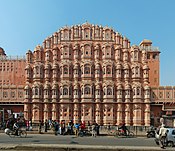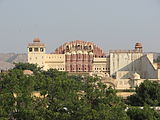Hawa Mahal
From Wikipedia, the free encyclopedia
For other uses, see Hawa (disambiguation).
For the radio show, see Hawa Mahal (radio program).
| Hawa Mahal | |
|---|---|
 Hawa Mahal or "Palace of the Winds", Jaipur, 16 December 2008 | |
| General information | |
| Architectural style | Fusion of Rajput Architecture andMughal Architecture |
| Town or city | Jaipur |
| Country | India |
| Coordinates | 26.923611°N 75.826667°E |
| Completed | 1799 |
| Technical details | |
| Structural system | Red and pink sand stone |
| Design and construction | |
| Client | Maharaja Sawai Pratap Singh |
| Architect | Lal Chand Usta |
Hawa Mahal (Hindi: हवा महल, translation: "Palace of Winds" or “Palace of the Breeze”), is a palace in Jaipur, India. It was built in 1799 by Maharaja Sawai Pratap Singh, and designed by Lal Chand Ustad in the form of the crown of Krishna, the Hindugod. Its unique five-storey exterior is also akin to the honeycomb of the beehive with its 953 small windows called jharokhas that are decorated with intricate latticework.[1] The original intention of the lattice was to allow royal ladies to observe everyday life in the street below without being seen, since they had to observe strict "purdah" (face cover). Besides this, the lattice also provides cool air caused by the venturi effect (doctor breeze) through the intricate pattern and thereby air conditioning the whole area during the high temperatures in summers. [1][2][3]
Built of red and pink sandstone, the palace is situated on the main thoroughfare in the heart of Jaipur’s business centre. It forms part of the City Palace, and extends to theZenana or women's chambers, the chambers of the harem. It is particularly striking when viewed early in the morning, lit with the golden light of sunrise.[2][3]
Contents[hide] |
Architecture[edit]
 |
| The complete view of facade from the main road |
 |
| Full rear view of the Hawa Mahal |
The palace is a five-storey pyramidal shaped monument that rises to a height of 50 feet (15 m) from its high base. The top three floors of the structure have a dimension of one room width while the first and second floors have patios in front of them, on the rear side of the structure. The front elevation, as seen from the street, is like a honeycomb web of a beehive built with small portholes. Each porthole has miniature windows and has carved sandstone grills, finials and domes. It is a veritable mass of semi-octagonal bays, which gives the monument its unique façade. The inner face on the back side of the building consists of need-based chambers built with pillars and corridors with least ornamentation, and reach up to the top floor. The interior of the Mahal has been described as “having rooms of different coloured marbles, relieved by inlaid panels or gilding; while fountains adorn the centre of the courtyard”.[4][5]
Anal Chand Ustad was the architect of this unique structure who also planned Jaipur city, considered then as one of the best-planned cities in India. Built in red and pink coloured sand stone, in keeping with the décor of the other monuments in the city, its colour is a full testimony to the epithet of “Pink City” given to Jaipur. Its façade depicts 953 niches with intricately carved Jharokhas (some are made of wood) is a stark contrast to the plain looking rear side of the structure. Its cultural and architectural heritage is a true reflection of a fusion of Hindu Rajput architecture and the Islamic Mughal architecture; the Rajput style is seen in the form of domed canopies, fluted pillars, lotus and floral patterns, and the Islamic style is evident in its stone inlay filigree work and arches (as distinguished from its similarity with the Panch Mahal - the palace of winds - at Fatehpur Sikri).[6]
The entry to the Hawa Mahal from the city palace side is through an imperial door. It opens into a large courtyard, which has double storeyed buildings on three sides, with the Hawa Mahal enclosing it on the east side. An archaeological museum is also housed in this courtyard.[7]
Hawa Mahal was also known as the chef-d'œuvre of Maharaja Jai Singh as it was his favourite resort because of the elegance and built-in interior of the Mahal. The cooling effect in the chambers, provided by the breeze passing through the small windows of the façade, was enhanced by the fountains provided at the centre of each of the chambers.[8]
The top two floors of the Hawa Mahal are accessed only through ramps. The Mahal is maintained by the archaeological Department of the Government of Rajasthan.[7]
Restoration and renovation[edit]
In 2005, restoration and renovation works on the Mahal were undertaken, after a long gap of 50 years, to give a face lift to the monument at an estimated cost of Rs 45679 lakhs.[9] The corporate sector is also lending a hand to preserve the historical monuments of Jaipur and the Unit Trust of India has adopted Hawa Mahal to maintain it.[10]'
Visitor information[edit]
The Mahal, called the “specimen of fanciful architecture”,[citation needed] is located to the south of the Jaipur city, at the main road intersection called the Badi Chaupad (big four square). Jaipur city is well connected by road, rail and air links with the rest of the country.[6] Jaipur Railway Station is a central main station on the broad gauge line of the Indian Railways. As well, Jaipur is connected by major highways, and by the International Airport at Sanganer, at a distance of 13 kilometres (8.1 mi) from the city.
Entry to the Hawa Mahal is not from the front but from a side road to the rear end. Facing the Hawa Mahal, turning right and again to the first right, leads to an archway entry and then to the rear side of the building.[11]









No comments:
Post a Comment